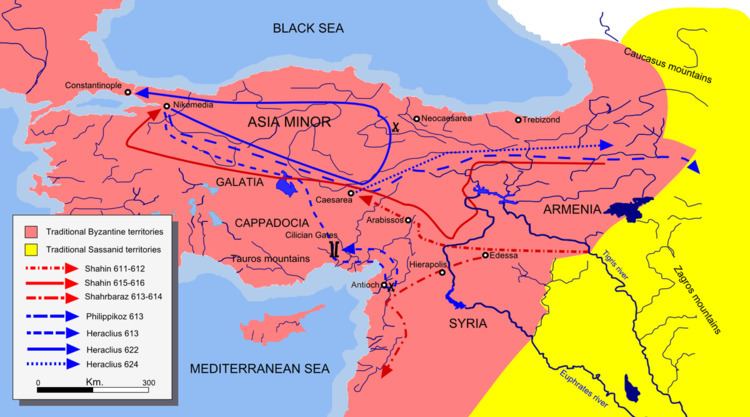Died 626 AD, Transcaucasia Name Shahin Vahmanzadegan | Years of service 590–626 Rank Spahbed | |
 | ||
Similar People Heraclius, Kavadh I, Bahram Chobin, Khosrow II, Maurice | ||
Commands held Governor of Asorestan | ||
Shahin vahmanzadegan and the city of sardis
Shahen or Shahin (Middle Persian: Shāhēn Vahūmanzādagān, in Greek sources: Σαὴν; died ca. 626) was a senior Sasanian general (spahbed) during the reign of Khosrau II (590–628). He was a member of the House of Spandiyadh.
Contents
Biography
Shahin is first mentioned in 602, after the outbreak of the Byzantine–Sasanian War of 602–628, where he commanded the forces invading Byzantine territory in the Transcaucasia, winning a battle against Domentziolus near Theodosiopolis in 607/8. Following the expulsion of Roman forces from that region, in 611 Shahin led an advance into Anatolia, capturing Caesarea. There, Phocas' son-in-law Priscus, started a year-long siege to trap them inside the city. However, Shahin's troops escaped Priscus' blockade and burned Caesarea, much to Heraclius' displeasure. In 613 the Roman offensive pressed on into Syria, but the combined Persian armies under Shahin and Shahrbaraz crushingly defeated Heraclius near Antioch. After this victory the Persians looted the city, slew the Patriarch of Antioch and deported many citizens. Roman forces lost again while attempting to defend the area just to the north of Antioch at the Cilician Gates, despite some initial success. The Persians then captured Tarsus and the Cilician plain. This defeat cut the Byzantine empire in half, severing Constantinople and Anatolia's land link to Syria, Palestine, Egypt, and the Exarchate of Carthage.
In 614 Shahin was able to campaign all the way across Anatolia to Chalcedon on the shore of the Bosphoros opposite Constantinople. On the shore of Chalcedon, Heraclius held a conference with Shahin, who, before Heraclius descended from his galley, saluted with reverence and pity the majesty of the purple. The friendly offer of Shahin to conduct an embassy to the presence of the great king, was accepted with the warmest gratitude, and the prayer for pardon and peace was humbly presented by the praetorian prefect, the prefect of the city, and one of the first ecclesiastics of the patriarchal church. But the lieutenant of Chosroes had fatally mistaken the intentions of his master:
According to the history of the Patriarch Nicephorus, Shahin, for his presumption, was flayed alive and his skin was used to make a bag. However this is inconsistent with the account of Theophanes the Confessor, who claims that Shahin fought against Byzantine forces in the following years.
Despite overwhelming Persian successes spanning almost two decades of war, from 622 Heraclius led a fresh counter-offensive in the Transcaucasus which brought about a remarkable revival of Byzantine fortunes. By 624, Heraclius wintered in Caucasian Albania, gathering forces for the next year. Khosrau was not content to let Heraclius quietly rest in Albania. He sent three armies, commanded by Shahin, Shahrbaraz, and Shahraplakan, to try to trap and destroy Heraclius' forces. Shahraplakan retook lands up as far as Siwnik, aiming to capture the mountain passes. Shahrbaraz was sent to block Heraclius' retreat through Caucasian Iberia, and Shahin was sent to block the Bitlis Pass. Heraclius, planning to engage the Persian armies separately, spoke to his worried Lazic, Abasgian, and Iberian allies and soldiers, saying: "Do not let the number of our enemies disturb us. For, God willing, one will pursue ten thousand."
Two soldiers who feigned desertion were sent to Shahrbaraz, claiming that the Byzantines were fleeing before Shahin. Due to jealousy between the Persian commanders, Shahrbaraz hurried with his army to take part in the glory of the victory. Heraclius met them at Tigranakert and routed the forces of Shahraplakan and Shahin one after the other. Shahin lost his baggage train, and Shahraplakan (according to one source) was killed, though he re-appears later. After this victory, Heraclius crossed the Araxes and camped in the plains on the other side. Shahin, with the remnants of both his and Shahraplakan's armies joined Shahrbaraz in the pursuit of Heraclius, but marshes slowed them down. At Aliovit, Shahrbaraz split his forces, sending some 6,000 troops to ambush Heraclius while the remainder of the troops stayed at Aliovit. Heraclius instead launched a surprise night attack on the Persian main camp in February 625, destroying it. Shahrbaraz only barely escaped, naked and alone, having lost his harem, baggage, and men.
Death
Shahin then regrouped with Shahrbaraz, shadowing Heraclius through Armenia in an inconclusive campaign for the remainder of that year. In 626 Khosrau ordered an exceptional levy of troops from across his empire to revive the faltering war effort. Shahin was put in charge of these new recruits, together with a large number of veterans, and sent against Heraclius, but was heavily defeated by the emperor's brother Theodore. The dejected Shahin fell ill and Khosrau, enraged at Shahin's failure, mistreated the general's corpse, which had been sent to him preserved in salt.
